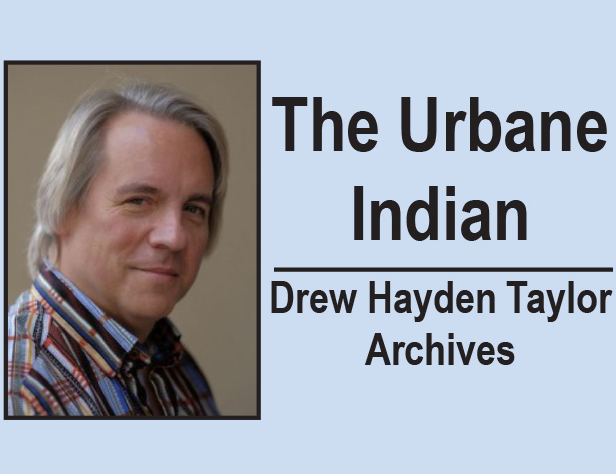
By Drew Hayden Taylor
Original published in February 2015
I am a playwright, amongst a few other related professions. More specifically, a First Nation playwright, a contemporary storyteller, a teller of tales both dark and amusing.
I, like many of my fellow literary artists, spend my career writing about the issues and problems faced by our present day Native population. For many, it’s a way of dealing with the trauma caused by what I call P.C.S.D (Post Contact Stress Disorder).
Many Indigenous cultures around the world suffer from it. It often manifests itself in an inability to comfortably co-exist with in an invasive culture, and a difficulty in manoeuvring through its complex and oppressive social conventions, frequently resulting in tragic situations.
Our contemporary literature is rife with stories about the scoop-up, residential schools, the reserve system, racism, and the other many repercussions of colonialism.
There is a line in the introduction to Tomson Highway’s play, “The Rez Sisters”, where it’s stated “Before the healing can take place, the poison must be exposed.” That is why we write. Think of us as putting our lips to the wound and trying to suck out the poison.
The issue de jour in the Native community seems to be the 1,200 missing and murdered Aboriginal women in Canada. I do not say this flippantly. If there is ever such a topic that needs addressing, I cannot think of a better one.
For the last 10 or 15 years, there has been a plethora of fiction and non-fiction books and plays coming out of the Native community dealing with residential school survival. I know, I have written one myself. So it’s only natural that this new horrible statistic will be necessarily embraced and explored artistically.
I myself have been toying with the idea of crafting a story attacking this issue. Already an anthology titled “Kwe: Standing With Our Sisters,” published by Penguin Books was launched in December. The book contains never before published material by such authors as Joseph Boyden, Lee Maracle and Richard Van Camp. All royalties will go to Amnesty International: No More Stolen Sisters.
But how does one tackle a story like this on a larger dramatic canvas? In the larger Canadian and Aboriginal literary community, I am primarily known as a humourist, but obviously, that’s not the path to follow. I have yet to see a successful comedy about the Holocaust. Some might argue the Academy Award winning Italian film “Life Is Beautiful” attempted that, but personally I am not sure how successful it was.
Last December when I was in Trivandrum, India participating in a conference on cultural humour, I sat in the audience listening to a woman from Tel Aviv, Israel give a lecture on ‘Humour and the Holocaust”. However, her talk dealt more with Jewish humour than specifically the Holocaust.
Back to my point, 1,200 missing and murdered Aboriginal women—The Play. There certainly wouldn’t be a lack of characters to choose from. To start off with, there are those 1,200 women, plus the dozen or so people that knew each of them and cared for them (I am being admittedly conservative here but I needed a number to play with). There are several different villains/antagonists, ranging from the evil and despotic men responsible for the issue being discussed, to the leader of this country who insists the mysterious absence on this planet of those women is merely a coincidence of crime, not a sociological phenomenon.
After all, who could possibly conceive the disappearance of 1,200 racially similar women, many of them with the same socio-economic background, having a sociological origin? I mean, you have 1,200 Native women (or men) doing anything together any other time and the sociologists and anthropologist would be all over it.
As for a location for the play to take place…. How about all across the country? The whole nation is a stage. In fact, much of the action is still taking place. Ask Renelle Harper and Tina Fontaine in Winnipeg. Actually, you can’t ask Tina. Same with Loretta Saunders. She was an Inuk student living in Halifax that was found murdered last February. Ironically she was attending university and studying the issue of missing and murdered Aboriginal women. A touch of tragic irony for the play.
Perhaps my friend Columpa Bobb put it best. She’s a Native actress and theatre director currently living in Winnipeg. “I am the most hunted urban bipedal mammal in our country. There is no bigger game than me. This both frightens me to my core, threatening to make me retreat into invisibility. It also bolsters my resolve to take my rightful human place.”
She reflects the sentiment of many Native women with whom I have chatted with across this country called Canada. It’s like a horror movie. Something insidious is happening to the Native women of this country, and the authorities just don’t believe it!
All things considered, I may leave the writing of this play/novel/movie to somebody else. For me, the third act still has yet to be written. I know it’s a long shot but I am hoping it has a happy ending.
If that’s possible.
